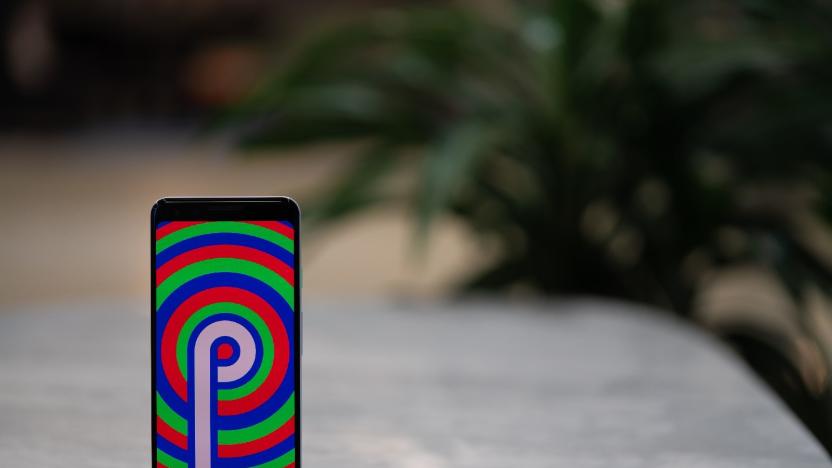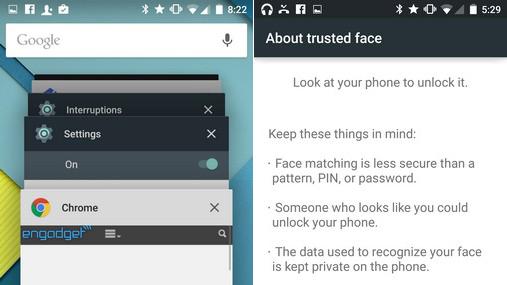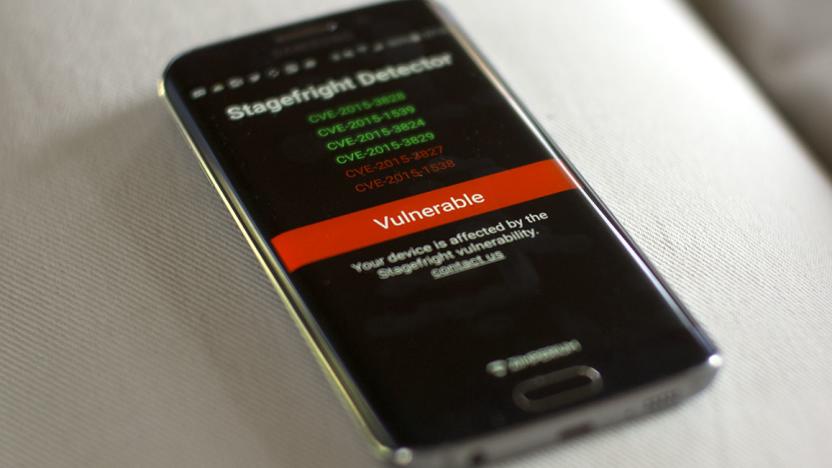lollipop
Latest

Android Pie hits 10 percent adoption two months ahead of its ancestors
Google left people in the dark regarding Android Pie's adoption for more than half a year, but it's finally lifting the curtain -- and Pie is doing better than its predecessors. Updated stats supplied to VentureBeat show that 10.4 percent of active users were using Pie after eight months. That may not sound like much, but it took about 10 months each for Oreo and Nougat to reach the 10 percent milestone. Google's efforts to spur Pie's uptake appear to have paid off, even if it's not a night-and-day difference.

Android's Clock will wake you up with tunes from Spotify
Android users' morning ritual might get a bit more musical. A new update to the Google Clock app adds an integration with Spotify so you can wake up with your favorite track or playlist rather than a droning alarm. As TechCrunch points out, this will work with any handset running Android Lollipop and doesn't even require a Spotify Premium account to use. The update begins rolling out this week.

Google Assistant lands on older Android phones
Google Assistant has been available on recent Android phones for a while. However, that still puts it out out of reach of many Android users when a whopping 46.5 percent of active Android users are running a version older than Marshmallow. To help address this, Google is making Assistant available on devices running Android Lollipop. If you're still rocking an older phone, you'll get the same AI helper as a shiny new handset.

Samsung inexplicably opens up its Android browser
Samsung has announced that the new version of its browser, Samsung Internet, can be used on any relatively new Android phone, which is good news if you're bored of existing mobile browsers that already do the job perfectly well. The Korean tech giant made its software ambitions known in March when, in response to "many requests", it released a beta version of Samsung Internet (5.4) compatible with Google devices such as the Pixel and Nexus series. Now, the v6 beta version is being released for any phone running Android 5.0, aka Lollipop, or later.

Candy Mechanics turns heads into 3D chocolate lollipops
The holidays are a time to forget about your fitness goals and indulge. And what better to stuff your face with than, well, your face? Candy Mechanics is in the business of personalised chocolate, but the company's latest service takes that idea one step further: chocolate people. Or rather, chocolate heads, known as Lolpops. All you need is a smartphone or tablet to film a 30-second, close-up video of someone's mug from all angles (Candy Mechanics' website talks you through the process). Upload that video, and fancy Autodesk software builds a 3D model from the footage that's then used to create chocolate heads on sticks.

Android can launch apps based on where you are
Google really wants the apps you use to take the context of where you are into account. Thus Nearby, a feature that uses Bluetooth and your device's GPS to deliver you apps based on where you are. The post on Google's official Android blog gives a few examples of how this might work: printing photos directly from your phone when you're in a CVS Pharmacy or using the Mobile Passport app to duck the customs line at certain airports.

Chrome 51 on Android brings tabs back
Now that Google has officially released Chrome 51 on Android, it's reversed a change that came with Lollipop in 2014. That release of Android brought in the option to "Merge tabs and apps" which put open tabs in the app switcher instead of all in one process and was on by default. The only problem was that we disliked it from the start, and so did many others, who quickly disabled it. Now the option is gone altogether, and the old tab selecting option is back by default. As we noted in our Lollipop review, it's just an easier way to keep track of tabs, and also makes it easier to scroll through any recently opened apps. If you don't have the new version already, check Google Play for an update.

Marshmallow is now on 10 percent of Android devices
The latest version of Android just hit a big, big milestone. Google's early June developer stats have revealed that Marshmallow is now on just over 10 percent of Android devices, representing a huge jump from just 2.3 percent in March. Notably, only some of that surge can be credited to people upgrading from Lollipop. While the not-quite-current version's adoption did go down (to 35.4 percent), the biggest declines in usage were for Jelly Bean and KitKat. In essence: many of those moving to Marshmallow may well have been replacing devices that were 3 or more years old.

Lollipop becomes the most popular version of Android
At last, there's a new flavor of Android on top of the heap. Google has published updated stats which show that Lollipop is now the most-used version of Android, snagging 36.1 percent of device share in early March versus former champ KitKat's 34.3 percent. It's a big milestone that suggests many Android users are using a reasonably modern take on the mobile platform.

Omate Rise is a circular Android 3G smartwatch for just $200
Omate probably isn't the first brand that comes to mind when you think of smartwatches, but the truth is it was one of the first to launch a 3G-enabled smartwatch. It's been over two years since then but such devices have yet to fully take off, not to mention that LG has recently canned its latest LTE watch. But that's good news for Omate who is launching the Rise, a $200 fully circular smartwatch, via Indiegogo on December 7th. Much like its predecessor, the Rise runs on full Android 5.1 (customized with Omate's new OUI 4.0) instead of Android Wear, meaning you can side load any regular Android app -- including all the missing Google Play services -- onto it. But of course, you'll have to get used to poking around on that 1.3-inch, 360 x 360 round LCD. Additionally, the Rise also works as a notification watch with phones running on either iOS 9 or Android 4.4 and above.

Nearly a quarter of Android users are running Lollipop
Android Lollipop is enjoying its last, shining moment in the sun before Marshmallow arrives in earnest. Google's not-quite-current operating system now accounts for 23.5 percent of active Android users, a healthy 2.5-point boost from what you saw just one month ago. That's still trailing behind Jelly Bean (30.2 percent) and KitKat (38.9 percent), but it's clear that all those new devices and upgrades are starting to add up. The real question is whether or not that momentum will last. Marshmallow is arriving relatively quickly, and shouldn't suffer from the early performance and battery life woes that kept some people from upgrading last year. If the newer release catches on quickly, Lollipop might not reach the lofty adoption rates of its predecessors.

Vertu's posh smartphone is probably more powerful than yours
If you're going to shell out $9,900 or more on a smartphone, you're either nuts or you've really made it in life. Or both. Either way, Vertu's done its part by updating its flagship luxury smartphone line, the Signature Touch, with pretty much all the best specs available in the current market. As CEO Max Pogliani put it, this "is the most complete Vertu smartphone that we have ever produced." Most notably, this new titanium device runs on Android 5.1 and packs an octa-core Snapdragon 810 chipset with 4GB of RAM, along with 64GB of internal storage plus another 64GB on the included microSD card (expandable up to 2TB). Funny how at a time when mainstream players like Samsung, Xiaomi and OnePlus are staying away from microSD expansion, Vertu found no issues with this feature and has therefore chosen to side with spec-hungry folks like us this time.

Omate has a smartwatch that runs Lollipop and makes phone calls
Let's face it: deep down we probably all have wanted a smartwatch made by wearables company Omate that runs Android 5.1. Okay, that's an overstatement. But there are at least a few folks out there that fit this bill and they'll likely be pretty pleased about the news that the new call-capable TrueSmart+ is Lollipop flavored. The company took to Facebook to announce that both the TS+ and its slightly cheaper sibling will hit sometime either late October or in November for $169 and $149, respectively. Oddly enough, the pricier model doesn't have a built-in camera like its predecessor but Omate says it has a TSi model with one.

Android security flaw lets attackers in using a large password
There have been plenty of security holes involving mobile device lock screens, but a recently discovered Android flaw may give you more reasons than usual to be cautious. The technique bypasses the lock screen on most versions of Android Lollipop by crashing it with any large-enough password -- all you need to do is work with that text while the camera app is open, and then enter it into the password prompt. When the attack works, you have as much access as the hardware's rightful owner.

'Stagefright' vulnerability files released to the wild
On the heels of its Stagefright detection app, Zimperium (the outfit that discovered the Android security flaw) has released its exploit to the public. But before you get your hands dirty tinkering with it to find a fix there are a few things you need to consider. Zimperium says that it was tested on a Nexus device that was running Ice Cream Sandwich 4.0.4 and that "due to variances in heap layout" this exploit isn't entirely reliable. The Python script does work to take advantage of "one of the most critical" vulnerabilities the outfit discovered in the security flaw's library, however. Perhaps the biggest caveat, though, is that since the file was tested with Ice Cream Sandwich, Zimperium says that elements of Android 5.0 Lollipop, the fast-growing OS of choice for Android users, basically nullify its attempts to address the problem.

Android Lollipop is the OS of choice for one in five users
If you own an Android device, find four similarly outfitted friends and line up, shoulder-to-shoulder. Look to your left. Look to your right. Chances are, one of you has Lollipop, the latest Android mobile operating system. Twenty-one percent of Android devices use Lollipop, according to the company's own breakdown. This figure is up significantly from May, when Android reported just nine percent of its devices used the new OS. The largest share of the Android OS pie goes to Kit Kat, with 39 percent, followed by Jelly Bean with 32 percent.

Amazon launches Fire OS 5 dev preview, based on Android Lollipop
Amazon is still trucking along with its customized version of Android -- though we'd imagine updates are more focused on the company's Kindle Fire tablets and TV hardware, rather than the disastrous Fire Phone. Developers can get their hands on a preview version of Fire OS 5 today, while the final version is coming later this fall. The new OS finally brings Android Lollipop to the company's devices, though you likely won't see many of Google's interface improvements under Amazon's skin. The addition of Lollipop should also make Fire OS 5 compatible with more Android apps than before. Amazon's also updated its online testing service to tell developers if their apps are compatible with the new OS in 90 seconds. [Photo credit: AP Photo/Reed Saxon]

Sony's Xperia Z3+ is a familiar flagship
Sony announced the Xperia Z4 for Japan last month, but this isn't it. Well it is, but internationally Sony wants it to be known as the Xperia Z3+. Truth be told, that's a more appropriate name for the phone, given the incremental upgrade it represents over last year's model. The Z3+ may look virtually identical to its predecessor, but internally it has almost everything you'd expect from a 2015 flagship.

At £199, Google's Nexus 9 finally makes sense
Ever since Google launched the Nexus 10, I've craved a decent full-size Android tablet. Sony's Xperia slates are nice enough, but I've always missed the purified software experience that comes with Nexus devices. When the Nexus 9 was announced, I thought a worthy upgrade had arrived, but it quickly became clear that the hardware wasn't up to HTC's usual standards. The plastic back creaked and the display suffered from light leaks, while the price, which originally started at $399/£319, felt a little on the high side.

Android Lollipop is gaining more users as new flagships come out
It took a while for Android Lollipop to even get its own slice on the OS pie chart Google releases regularly, but it now seems to be steadily gaining popularity. According to the latest Android stats collected from April 28th to May 4th, nine percent of devices are now running Lollipop. While that's still quite small, it's almost double last month's percentage (five percent). KitKat's stat slid down to 39.8 percent from last month's 41.4 percent, so a number of stragglers might have finally upgraded. However, we're sure the new flagships that recently started shipping with Lollipop out of the box (such as the Samsung Galaxy S6 and S6 Edge) helped boost the version's usage. All the older versions' percentage are slightly down from last month's, as well, but Froyo's impressively still hanging on at 0.3 percent.










